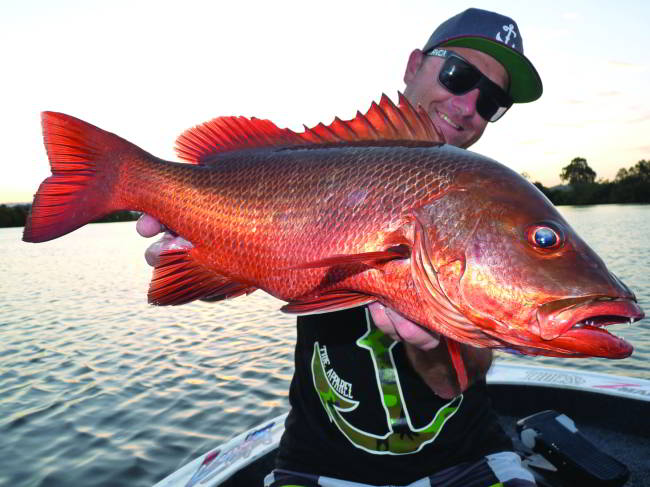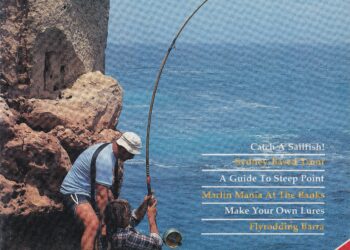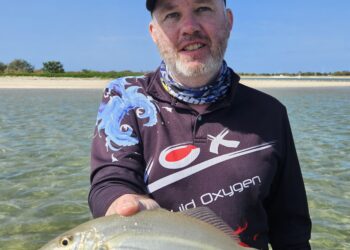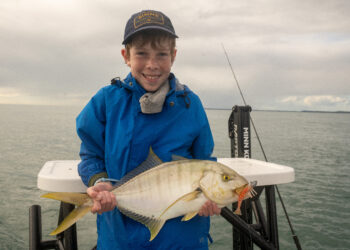ON the Gold Coast we have a large and growing population of mangrove jacks that have adapted well to living around the man-made structures, bridges and pontoons in this region.
These jacks are amongst the biggest estuary jacks in the country, with plenty over 50cm being caught. Sixty plus centimetre fish are increasingly starting to show up.
In southern Queensland, mangrove jacks tend to stay in the estuary for a greater part of their life cycle whereas more northern fish tend to migrate to the inshore and offshore reefs at around 45cm in length.
Gold Coast jacks aren’t an easy target and require dedication and persistence to catch. A lot of hours can go into every capture.
The local jack legend is Mick Horn, a bloke who dedicates three to four sessions a week in the pursuit of big jacks. You can follow Mick’s captures on his popular Facebook page, Mick Horn’s Fishbook.
Mick is a great example of an angler dedicated to a single species. He has an unbridled passion to catch his next big “red dog” as soon as possible, preferably that day or the next.
He is a 39-year-old graphic designer who’s been fishing for jacks for 20 years. I caught up with Mick to have a chat about those fabulous big red fish. He is one of the most passionate anglers I’ve ever met and a great bloke.
DG: Hi Mick, where have you fished for jacks?
MH: Over the past 20 years I’ve fished for them between Coffs Harbour in NSW and Baffle Creek on the Central Queensland coast. But most of my fishing has been on the Gold Coast, especially over the past few seasons. Each year I seem to be catching more and more.
DG: What’s your favourite river system for jacks?
MH: I like the Coomera River system and the Gold Coast Broadwater, but each year I explore new ground.
DG: You use a whole range of methods, what is your general approach to lure selection.
MH: It depends where you’re fishing, time of year and what the bite is like. A lot of the time I fish soft plastics, particularly around pontoons, bridges and poles in spring and early summer.
I mix this up with hard-bodies as well, but I love fishing surface lures which is at its best from February to April.
Lately I’ve caught nearly all my big fish on quick retrieved plastics and I’ve started using bigger lures such as the six-inch Z-Man Swimmerz and the DieZel minnow.
A 65cm fish I caught in October, my PB, ate a six-inch lure cranked along the edge of a pontoon that I haven’t caught a fish on in more than a year.
DG: Favourite soft plastics?
MH: I really like the Z-Man four-inch Swimmerz. They are tough, have great action, good tail beats on the drop and have caught me a lot of fish.
The dark green “Golden Shiner” is a great colour in dirty water, and white is my favourite colour in cleaner conditions, but I try most of the colours in the range at different times.
The six-inch Z-Man Swimmerz is also good, particularly when the bite is on and the fish are hitting hard.
The new DieZel minnow is also a great tail which caught my PB jack. I’ve used a lot of plastics over the years and am now sponsored by TT who bring in Z-Mans. These plastics have been fantastic jack producers for me.
DG: Favourite hard-bodies?
MH: Around bridges where there is a lot of current and snags I like the Lucky Craft 100mm and 75mm Pointers. I caught a lot of fish on those over the past few seasons.
When I’m fishing rock walls I like the 75mm Lucky Craft Bevy Shads. During the middle of the day you can sometimes get a late fish on a smaller lure.
One of my best captures was a 63cm jack on a small Maria Bream Crank on 4lb in the Nerang River, which shows even with big jacks you sometimes can get lucky.
The most important thing with hard-bodies is to get them right in to the shadows, close to cover, and learn to work them properly. Different retrieve styles suit different conditions.
DG: I know you love catching jacks on surface lures, what is your favourite surface lure?
MH: I love using the Lucky Craft G Splash. It is the best jack surface lure I’ve come across, and the big red fish just want to smash it. While I must point out that Lucky Craft is a sponsor of mine, which is handy as in this business lure losses are high at times, they are great lures and I just love using them and feel confident every time I put one on.
DG: How many jacks are you catching, Mick?
MH: In 2012 I cracked the hundred for probably the first time in a season, but they seem to be getting more in numbers each year. In September 2013 I caught 30 with three over 60cm, and I lost a few crackers as well.
There are a lot of big fish around at the moment (October 2013). At first they were just coming out and rolling on the lure, but as it warmed up a bit they are smashing it.
DG: What do you like in a jack rod?
MH: I don’t like too stiff a tip; the high modulus type blanks just seem to make them angry! I like a rod with a softish tip and a strong middle so I can really lean on the fish when I hook up.
At the moment I am using a Dobyn’s Savvy 664 baitcaster and it is a great stick well suited to my fishing style, and pretty good value as well. I stay away from stiff tips for jacks as I seem to lose more on the stiffer rods.
DG: What reels do you use?
MH: Nearly all my jack fishing is with baitcasters and I pretty much use the Daiwa HRFs and Lexas. The 6.3:1 retrieve on these reels comes in handy.
I retrieve fast most of the time and a high-speed reel is a big advantage as on the hookup you can turn the fish faster on a burning type retrieve, provided you are paying attention.
DG: Line and leader?
MH: I use Sunline Castaway or Momentum in 20 or 30 pound. I always tie a short Bimini Twist as a double, and I use FC Rock in 20 to 40 pound depending on the conditions and where I’m fishing. The FC Rock is tough and reliable, but as you can see from my GoPro footage, I still get busted a fair bit.
DG: You’ve honed your skills very carefully over a long time, Mick, and you’ve definitely caught more jacks in these waters than anyone I know. What conditions do you look for?
MH: I tend to go when I can go, so I’ve spent a lot of time fishing all winds, tides and barometers. In general I fish for jacks between August and May, and I like the last half of the run out and first of the run in for most places.
This often tends to concentrate the fish. I particularly like it on the first day of a northerly wind after a period of south easterlies – they seem to hit harder then.
I’ve got lots of spots and each seems to perform under slightly different conditions, so if I get off work at 3pm I’ve usually got a plan sorted, and I often fish early mornings as well. I fish till just on dark but I don’t fish on into the night.
I find that by going a lot and trying hard, one trip’s lessons feed into the next trip, and I’m always thinking about where my next big one is coming from. I’ve lost a few monsters lately and I’m always back there trying again, but if I’m on a spot and haven’t had a bite in 10 or so casts I tend to move on.
DG: How many hours do you reckon you fish per jack?
MH: That’s interesting. I recently went for a whole month, three or four times a week, without catching a single fish. They’d roll on the lure but not bite it. Since then the bite has hotted up a lot, but if you averaged it out over a season I think I’d do three to four hours fishing per fish caught.
I had one recent session where I got a 60, a 57, a 50 and a 45 in a bit over an hour, but when you add up all the dud trips, and they are easy to forget when you start catching jacks, it’d be three to four hours per jack. Sounds a lot but it would be about right.
In local waters my best trip was 13 between two anglers, and fishing by myself I’ve caught seven in a session. My main interest is catching really big ones. I call any jack over 55cm a thumper. The mark used to be 50cm but it has gone up a bit with big fish now more common.
I’ve caught 10 over 60cm with my best going 65cm, but a few years back I straightened the hook on a fish I saw that looked every bit of 70cm.
DG: Do you eat any of your jacks?
MH: Never. I let them swim in the livewell to recover a bit, take a few happy snaps and send them on their way. There’s a lot of interest in my Facebook page (Mick Horn’s Fishbook) and most of the good ones end up on that. It’s all great fun.
DG: I’ve watched you fish and what I noticed was you really wind those plastics fast. What led you to that retrieve?
MH: I noticed a few years back I did a dud cast that fouled and I ripped it back in, the lure unfouled and I got slammed, so I repeated the cast and caught another one.
When you fish next to pontoons the back of the pontoon is usually the key spot and the floating pontoons give the jacks cover on all parts of the tide. The fish face into the current. I cast right next to the pontoons and retrieve quickly. The lure isn’t far under the surface, and you will see 70 per cent of the hits.
I use a half-ounce TT Headlock or Headhunter jig head to keep it down a bit. I like to have the hook point near the head of the lure as that is where the jacks tend to bite. But yes, I really crank it out fast.
I sometimes vary this by letting the lure drop alongside the pontoon’s poles, particularly if the fish are following but not hitting.
DG: What advice would you give to a keen angler trying hard to catch his first Gold Coast jack?
MH: You can read about jacks, watch how to catch them on YouTube or look at DVDs but nothing substitutes for time on the water. Learning is by trial and error, and the more you go, the better you will do.
But it is important to be very focused and only fish for jacks. This means leaving all the bream, flathead and jewie gear at home.
Don’t expect to clean up on your first trip, but make sure you fish every cast as if it is going to catch a fish.
Work out your own patterns. The reason that big mangrove jacks are such a great fish to land is that they aren’t easy. But the more you go, the more you learn and eventually, the more you catch.
DG: Thanks Mick, it’s been a pleasure.
MH: Thanks Greeny.
See Mick In Action!
Mick Horn has compiled some pretty wild videos on his nifty Go Pro camera showing an impressive array of hook-ups, captures and monumental wipe-outs. Check out www.fishingworld.com.au for a selection of online vids featuring Mick’s amazing urban jack fishing action! It’s really cool stuff, especially some of the wipe-outs … As you’ll see, Mick doesn’t like losing fish …
– The Fisho team
Fact box: Where jack lives
Mangrove jacks are members of the Lutjanid family, which also includes red emperor, golden snapper, moses perch, large mouth nannygai and red bass amongst many other species.
A tropical species, jacks extend as far south as Sydney and are a relatively common catch in northern NSW and southern Queensland.
As mentioned in the main story, juvenile jacks live in rivers before heading offshore to reef systems.
The Gold Coast variety caught by Mick Horn are generally quite a bit bigger than the specimens caught when fishing Top End rivers. A 40-50cm jack caught in an NT or FNQ river system is a cracker but only seems to be average for Mick.
Why the southern jacks seem to live in estuaries longer than their northern cousins is a bit of a mystery … As noted in the main article, jacks are very structure orientated.
In a wild river, timber snags and rock bars are typically where you’d find jacks. The Gold Coast is about as far away from a pristine natural system as you can get, however, the relentless development of this area has been something of a boon for many fish species.
The endless rocky canals, pontoons, bridges and wharves that are a feature of the Gold Coast’s waterfront areas actually provide plenty of likely lairs for jacks, bream and estuary cod plus multitudes of bait species.
This is a prime example of fish species adapting – and thriving – in a man-made environment.
Luckily for gun anglers like Mick Horn, the jack’s wild and pugnacious attitude hasn’t been dulled by its move to an urban environment!
– The Fisho team.
This story was first published in the January 2014 issue of Fishing World magazine.





















